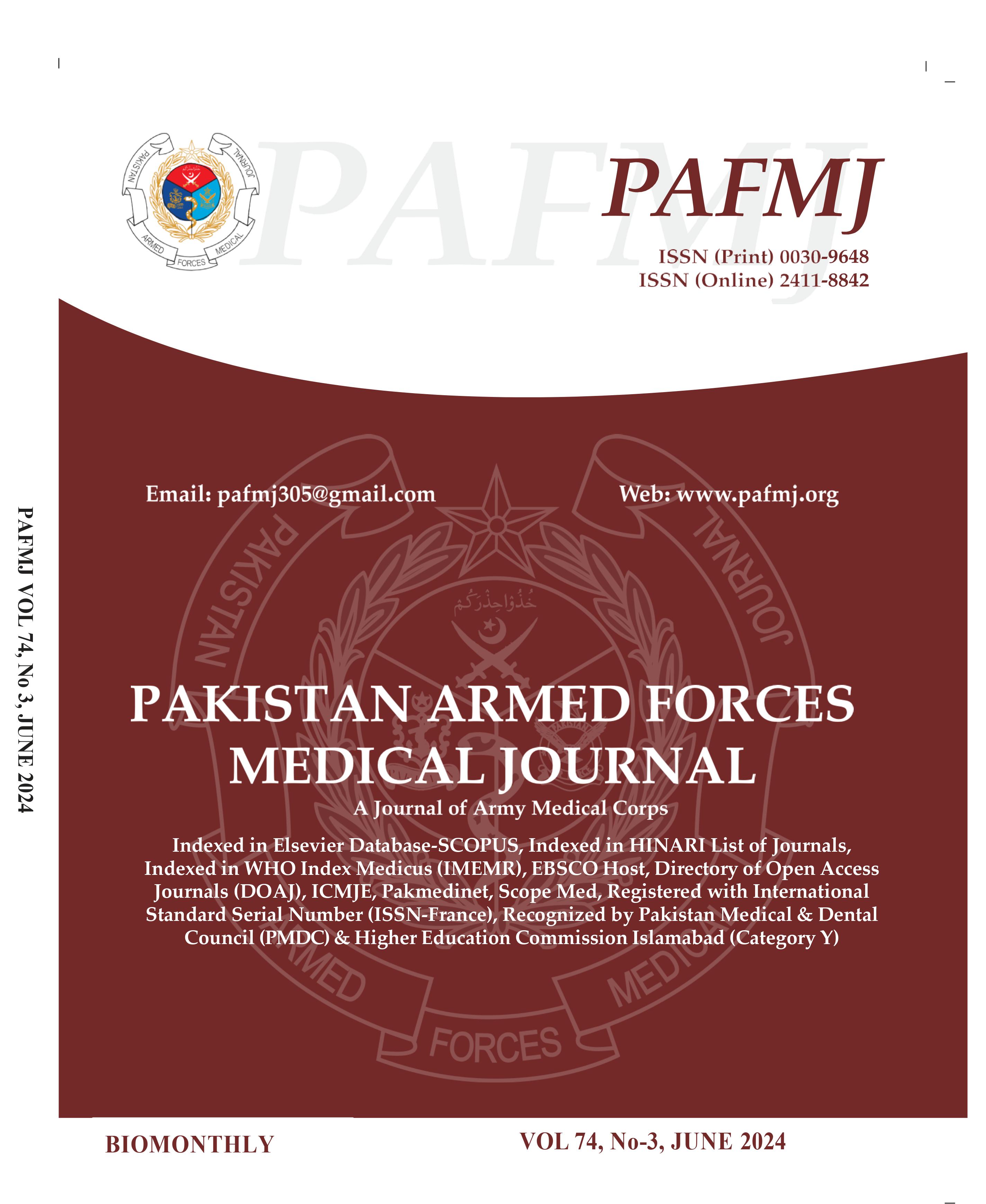Comparison of Gain In Length After Post Burn Contracture Release By Z-Plasty And Square Flap
DOI:
https://doi.org/10.51253/pafmj.v74i2.8447Keywords:
Gain in length, Post burn contracture Release, Square Flap, Z-plastyAbstract
Objective: To compare the mean differences in gain in length after post-burn contracture release by z-plasty and square flap.
Study Design: Case Series
Place and Duration of Study: Plastic and Reconstructive Surgery Department, Dr Ruth KMPfau Civil Hospital, Karachi Pakistan, from Apr to Sep 2021.
Methodology: Sixty patients were divided as Z-plasty and square flap groups. The length of the contracture zone was measured. Z-plasty was performed to improve the functional and cosmetic appearance of the scar. A square flap was made to release the contracture. Splintage was maintained for two weeks after its release.
Results: The mean contracture length three weeks after Z-plasty release was 7.12±4.14cm and 15.39±4.66cm in square flap. Significant mean differences among techniques were observed among contracture length (p=0.001) and gain in length (p=0.001). The cubital fossa was the most common region treated with Z-plasty, while the finger was the most common region treated with square flap. The results showed a highly significant association of regions with respect to surgical techniques (p=0.001). An insignificant association was observed between gender (p=0.436) and cause of burn (p=0.136).
Conclusion: The square flap technique provides greater length gains than a Z-plasty technique.
Downloads
References
Mathers CD, Bernard C, Iburg KM, Inoue M, Ma Fat D, Shibuya
K, et al. Global burden of disease in 2002: data sources, methods
and results. WHO Geneva; 2003.
Iqbal T, Saaiq M. The burnt child: an epidemiological profile and
outcome. J Coll Physicians Surg Pak 2011 ; 21(11): 691-694.
Ahuja RB, Dash JK, Shrivastava P. A comparative analysis of
liquefied petroleum gas (LPG) and kerosene related burns.
Burns 2011; 37(8): 1403-1410.
https://doi.org/10.1016/j.burns.2011.03.014
Sarma BP. Epidemiology and man-days loss in burn injuries
amongst workers in an oil industry. Burns 2001; 27(5): 475-480.
https://doi.org/10.1016/s0305-4179(00)00157-1
Bhattacharya V, Purwar S, Joshi D, Kumar M, Mandal S,
Chaudhuri GR, et al. Electrophysiological and histological
changes in extrinsic muscles proximal to post burn contractures
of hand. Burns 2011; 37(4): 692-697.
https://doi.org/10.1016/j.burns.2011.01.020
Hayashida K, Akita S. Surgical treatment algorithms for postburn contractures. Burns Trauma 2017; 5(1): 9-16.
https://doi.org/10.1186%2Fs41038-017-0074-z
Hove CR, Williams III EF, Rodgers BJ. Z-plasty: a concise
review. Facial Plast Surg 2001; 17(04): 289-294.
https://doi.org/10.1055/s-2001-18828
Altun S, Çakır F, Öztan M, Okur Mİ, Bal A. Do rhomboid flaps
provide more elongation than Z-plasty flaps? An experimental
study. J Plastic Surg Hand Surg 2018; 52(3): 148-152.
https://doi.org/10.1080/2000656x.2017.1372287
Hyakusoku H, Fumiiri M. The square flap method. British J
Plastic Surg 1987; 40(1):40-46. https://doi.org/10.1016/0007-
(87)90009-9
Hifny MA. The square flap technique for burn contractures:
clinical experience and analysis of length gain. Ann Burns Fire
Disasters 2018 ; 31(4): 306-312.
Karki D, Narayan RP. Role of square flap in post burn axillary
contractures. World J Plast Surg 2017; 6(3): 285–291.
Fernandez-Palacios J, Bayón PB, Sánchez OC, Duque OG.
Multilevel release of an extended postburn contracture. Burns
; 28(5): 490-493. https://doi.org/10.1016/s0305-
(01)00120-6
Aslan G, Tuncali D, Cigsar B, Barutcu AY, Terzioglu A. The
propeller flap for postburn elbow contractures. Burns 2006;
(1): 112-115. https://doi.org/10.1016/j.burns.2005.07.007
Baux S, Mimoun M, Kirsch JM, Zumer L, Berard V. Treatment of
elbow contractures in burns. Burns 1987; 13(3): 241-244.
https://doi.org/10.1016/0305-4179(87)90175-6
Lai CS, Lin SD, Tsai CC, Tsai CW. Running Y-V-plasty for burn
scar contracture. Burns 1995; 21(6): 458-462.
https://doi.org/10.1016/0305-4179(95)00019-8
Vartak A, Keswani MH. X-plasty for repair of burn contractures.
Burns 1992; 18(4): 326-328. https://doi.org/10.1016/0305-
(92)90156-o
Hyakusoku H, Fumiiri M. The square flap method. British J
Plastic Surg 1987; 40(1): 40-46. https://doi.org/10.1016/0007-
(87)90009-9
Ulkur E, Acıkel C, Evinc R, Celikoz B. Use of rhomboid flap and
double Z-plasty technique in the treatment of chronic postburn
contractures. Burns 2006; 32(6): 765-769.
https://doi.org/10.1016/j.burns.2006.01.015
Ertas NM, Küçükçelebi A, Erbas O, Bozdogan N. Comparison of
elongations provided by subcutaneous pedicle rhomboid flap
and Z-plasty in rat inguinal skin. Plast Reconstruct. Surg 2006;
(2): 486-90.
https://doi.org/10.1097/01.prs.0000197212.84348.db
Ostrowski DM, Feagin CA, Gould JS. A three-flap web-plasty
for release of short congenital syndactyly and dorsal adduction
contracture. J Hand Surg 1991; 16(4): 634-641.
Downloads
Published
Issue
Section
License
Copyright (c) 2024 Pakistan Armed Forces Medical Journal

This work is licensed under a Creative Commons Attribution-NonCommercial 4.0 International License.















